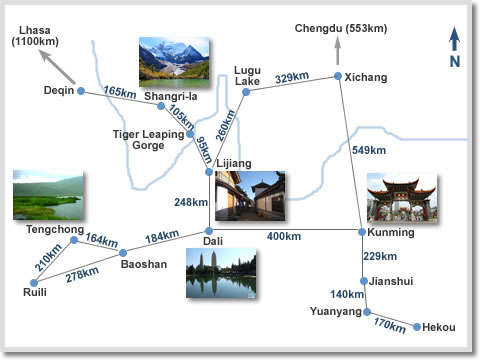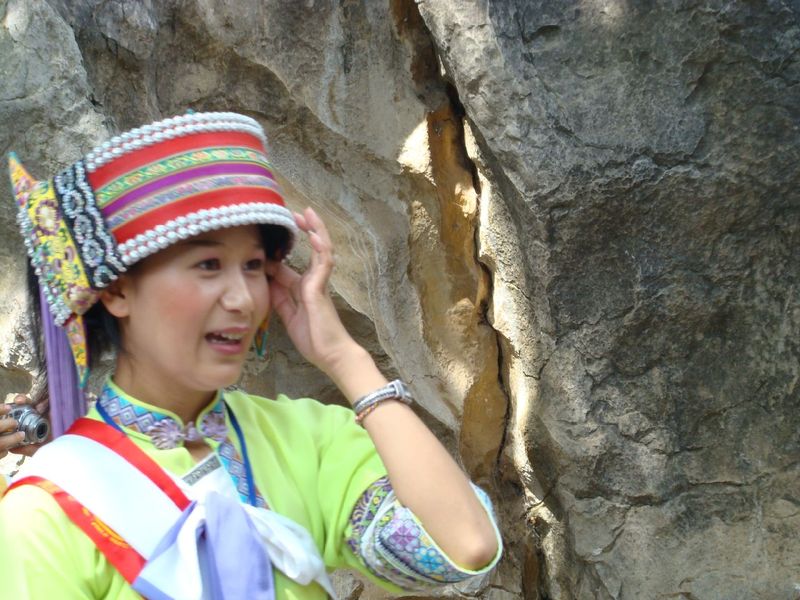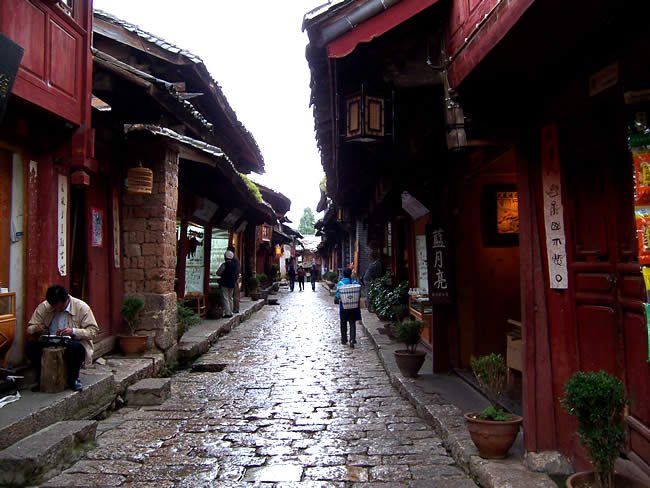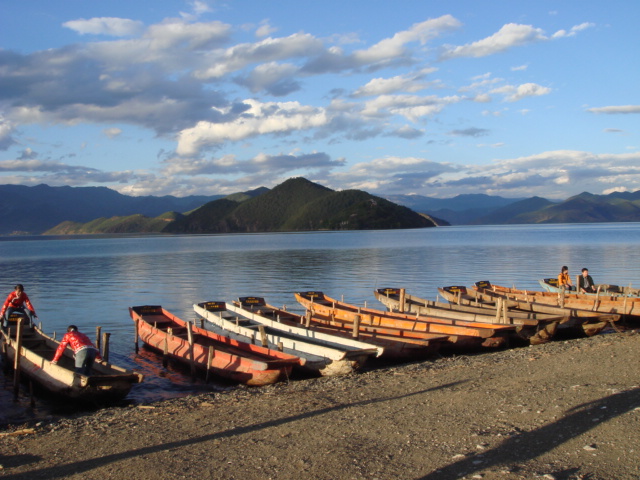『Yunnan Province』

YunNan
Also called Dian or Yun for short,
the southwest Chinese province of Yunnan covers an area of 380,000
square kilometers. During the Warring States period (475bc-221bc),the
region belonged to the State of Dian. In
the Tang and Song dynasties, it was under the jurisdiction of the state
called Nanzhao and Dali. During the Yuan Dynasty (1271-13680, Yunnan
province was founded. The province has a population of 42.88 million,
and is the home to 26 ethic peoples including Yi, Bai, Hani, Zhuang,
Dai, Miao, Hui, Lahu, and others. The population of minority
nationalities makes up one third of that of the province and take up one
seventh of that of chinese minority, all these make yunnan a province
with most ethnic minority in china. Kunking is the capital city of the province.
Yunnan is
situated on the yungui plateau, and mountain areas account for 94
percent of the province’s total land. Its complicated and varied
climates make it a best home to thousands of birds, animals and plants,
which win it a reputation of “the kingdom of plants and animals”. For
the reason of its favorable geographic conditions, yunnan is rich in
resources of tourism, countless cultural relics and historical sites.
Old town of lijiang and the three parallel rivers are world heritage
sites, and kunming, dali and lijiang are all national famous historical
and cultural cities. Dianchi lake, stone forest of lunan, xishuang
banna, and jade dragon snow mountain are listed as national important
scenic resorts. Other attractions are yuantong temple, grand view
pavilion, emerald lake park, black dragon pool, site of the world
horticultural exposition of kunming, manfeilong pagoda, three pagodas at
dali, butterfly spring, cangshan mountain, erhai lake, lugu lake, and
so on. Among the original folk festivals held here are the torch
festival in lunan, water-splashing festival in olive dam and the third
month street fair of dali.

4Old Town of LiJiang
ErHai
Just as its name implies, the erhai (ear lake), a fresh-water lake two kilometers northeast of dali, for the reason of its shape looks like that of an ear, thence it is named. covering 250 square kilometers and an average altitude of 1,966 meters, the blue, rippling lake and the snow-covered mt. Cangshan sitting on the western shore, add radiance and beauty to each other. the scene is, therefore, described as “silver mt. cangshan and jade erhai”.

Kunming
Kunming is the capital of Yunnan Province and a famous historical and cultural city in the center of Yunnan-Guizhou Plateau about 1,891 meters above sea level. with mild humidity, an average annual temperature of 15 degrees celsius, and flowers blooming in all four seasons, Kuming is called “spring town” by chinese people. As a world –famous tourist resort, kunming holds such major attractions as dianchi lake, west hill, west hill forest park, yunnan ethnic village, grand view pavilion, qiongzhu temple, golden hall, Yuangtong temple, Cuihu park,and the garden of the World Horticultural Exposition. The 300-square-km Dianchi is Yunnan’s largest alpine lake known as “highland bright pearl” for its vast expanse of liquid silver and graceful scenery. standing by dianchi lake is yunnan ethnic village, a huge congregation of ethnic villages in which visitors are entertained with a diversity of folk singing and dancing and folklore gigs. Dianchi lake itself is surrounded by many scenic attractions, including dianchi national holiday resort, west hill forest park, and grand view pavilion. china’s largest cast-bronze hall is found in Jindian (golden hall) zone on the camellia-covered Mingfeng mountain to the Northeast of Kunming. In 1999 from may 1st to October 30th, Kunming was the venue of the last international Horticultural Exposition, which was a resounding success. The large group of buildings erected for this exhibition has been converted into the garden of the World Horticultural Exposition, now open as a new tourist attraction to tourists.

DaLi
Located in the northwest yunna province, dali is a famous chinese
historical and cultural city and a national scenic zone. A rich heritage
could be dated back to the days when the city was the capital of the
kingdoms of nanzhao and dali. dali is a major habitat for the ethnic bai
people, whose folkways are once time-honored and distinctive. the
ancient city of dali was first built during the early ming dynasty;
today only two city gate towers are still there. the dwellings of the
bai people in the town are in perfect condition, straight streets
running from gate to gate with shops on both sides. the three pagodas of
the chongshen monaster, standing stately at the foot of cangshan
mountain and by erhai lake for more than 1,100 years, have become
the emblem of dali. the pagodas, the mountain and the lake are major
tourist attractions of dali. dali’s another attraction is the butterfly
spring, where the congregation of thousands of butterflies in the fourth
lunar month every year is indeed a feast to the eyes

LiJiang Naxi Autonomous County
Lijiang naxi autonomous county, 200 km away from dali is another famous
historical and cultural city, which is proud of the age-old towns,
imposing mountains and virtuous folk traditions. Major attractions:
ancient dayan town, snow-capped yulong mountain, hutiao gorge on jingsha
river, the first bend of the yangtze river, 10,000-flower camellia tree
in yufeng temple, and yuqian park. The naxi people, with a venerated
history and tradition, are marked for their unique dwelling
architecture, dress and living habits, and they are still using one of
the few pictographic languages in
today’s world. listening to the classicalnaxi music is an unforgettable
experience. The ancient city of lijiang is located at dayan, lijiang
naxi autonomous county and a 1.4-square-km town with an 800-year-old
history and 4,000 or so naxi families. the entire county is laid out
according to a well-conceived plan. the streets are tidy, the back
alleys are tucked away in remote corners, brooks and streams flow
through every courtyard, and every courtyard is a captivating garden of
trees and flowers. in 1997, dayan was put on the list of world cultural
heritage of the unesco. the snow-capped yulong mountain, 15 km north of
lijiang, is a national scenic resort and the site of a natural skiing
ground open in all four seasons. At an altitude of 5,596 meters above
sea level, it is the northern hemisphere’s southernmost mountain with
snow all year round. the yangtze river’s first bend is found at shigu
town, which is 53 km to the southwest of lijiang. There, the jinsha
river, which is the upper reaches of the mighty yangtze, flows from
northwest into a mountain cliff, and makes a v-shaped turn before
tumbling away to the northeast.

XiShuang BanNa
It takes 50 minutes to fly the 692 km from kuming to jinghong, capital of xishuang banna prefecture in southwest yunnan. there the land is covered with layers upon layers of primitive forests and tropical rain forests, forming what is called as “mid-air park”. For the reason of its favorable climate, it has become a homeland to some 5.000 kinds of tropical plants and hundreds of rare birds and animals. major sights: manfeilong white pagoda, mengang botanical garden, olive dam, wild elephant valley, lushi forest park and so on.

Three Pagodas
The three pagodas arise at the foot of Cangshan mountain overlooking the Erhai lake. They are also called the three pagodas of saintly worship for their location in front of the former monastery with the same name. Qianxun pagoda, the tallest of the three has 16 tiers and reaches a height of 69.13 meters. it is a close-eaved square brick pagoda built in a style of the tang dynasty (618-907). The two smaller octagonal pagodas, each 42 meters high with 10 tiers, have a luxurious appearance with their exquisite carvings. they were built in the five dynasties (907-960). In 1978 during the renovation works, many precious relics of the tang and song dynasties were discovered in the three pagodas , which make them even more famous.

Surrounded by snowcapped mountains, the mysterious valleys are lying
down on the vast grasslands of the plateau, where the pyramid-looked
snowcapped peaks, crystal-blue lakes and the age-old temples, churches,
like magnet, never fail to allure visitors and to stir the imagination
of the people living in towns.
This is the place named
"Shangri-La", the hidden paradise described by James Hilton in his novel
Lost Horizon. Zhongdian, with its virgin beauty, like a bright pearl,
is located in the "great triangle" of Yunnan, Sichuan and Tibet, as well
as the juncture of the three rivers (Nu river, Lancang river and Jinsha
river). Apart from its well-preserved natural ecology, Zhongdian also
has its unique folkways, which is simple and unsophisticated in the world.
For its unique topography, traveling from the Jinsha river toward the
land, one can experience the different climates and enjoy different
scenery within one day. Just like the local saying goes “there are four
season in one day; within 5 kilometers world could be different.” On the
way there are also many other attractions, such as the "tiger leaping
gorge", one of the world famous canyons, gedan songzan monastery forest,
also called small potala palace, the white water platform, which is
considered as the origin of dongba culture, the bita sea, a pearl in the
plateau and the napa lake, a paradise of crane.

Three Parallel Rivers of Yunnan Protected Areas
Consisting of eight geographical protected areas within the boundaries of the three parallel rivers national park, in the mountainous area of the northwest of yunnan province, the region covers an area of 40,000 square kilometers and features sections of the upper reaches of the three great rivers of asia: the yangtze, mekong and salween –namely, the jinsha, lancang and nu rivers –run roughly parallel about 400 kilometers, north to south, through steep gorges of the hengduan mountains. the region features the magnificent view of the three giant rivers, as well as the cultural interests of various ethnic groups in the area and rich biodiversity. The three parallel river region boasts rare high mountain landforms and outstanding biodiversity. The number of animal species alone in it accounts for more than 25 % of the nation’s total. meanwhile, it is also a place where 16 ethnic groups are located and that pools many languages, religions and ethnic habits and cultures. although the region only has less than 0,4 % of the total territory of china, it has more than 20 % kinds of advanced plants of the country’s total, therefore the site is an epicenter of chinese biodiversity. It is also one of the richest temperate regions of the world, in terms of biodiversity. In 2003, unesco had the three parallel rivers of yunnan protected areas enlisted on the world heritage list.

ErHai
Just as its name implies, the erhai (ear lake), a fresh-water lake two kilometers northeast of dali, for the reason of its shape looks like that of an ear, thence it is named. covering 250 square kilometers and an average altitude of 1,966 meters, the blue, rippling lake and the snow-covered mt. Cangshan sitting on the western shore, add radiance and beauty to each other. the scene is, therefore, described as “silver mt. cangshan and jade erhai”.

Scenic Lu Gu Lake
Ninglang county, some 200 km northeast of lijiang, is the site of the lugu lake, where the white clouds dotted blue sky with snow-capped mountains is reflected quiveringly in its crystal clear waters. The place is also the home to an “unusual matriarchal kingdom” –the local mosuo residents still manage to keep their matrilineal tradition very much intact in their daily life, dress, dwellings, marriage, etc.

Stone Forest
Covering a total area of 350 square kilometers, the stone forest is a masterpiece of the great nature. Out of a topographical turmoil, the stone forest is made up of a jungle of 100 or so groups of monoliths in various shapes ranging from overhanging cliffs to grotesque boulders. Situated in the shilin autonomous county of the yi nationality, about 84 km southeast of kunming, it consists of seven scenic areas –the big and small stone forests, naigu stone forest, dadieshui waterfall, moon lake, subterranean stone forest in zhiyun cave, and cave of magical wind. thousands of stone peaks and stone pillars, taking in various shapes such as pagodas, spears, animals or human being figures, are scattered here and there. It is reputed as “the most fantastic scenery under heaven”. Apart from the natural spectacle, another allurer to tourists is the inhabitants, the sani people around the stone forest and theirs unique culture, whose peculiar habits and customs never fail to make visitors captivated. Grand celebrations are held during the torch festival, which fall on the 24th day of the 6th lunar month.
As
a state-level ancient cultural town, lijiang is located in the
northwest of yunnan province and covers an area of 3.8 square
kilometers. the town has a history of 800 years. at the end of the
southern song dynasty (1127 –1279), the Naxi (also spelt Nakhi or Nahi)
ethnic group moved here and built the town. The town is famous for its
unique layout. The buildings in the town assimilates the architecture
styles of Han, Tibetan, Bai and other ethnic groups,
but still hold the traditional natural aesthetics of the Naxi people
and their interest in life. Together with the Dongba culture, Naxi
ancient music and Baisha fresco, all these are the testimonies of the
long and rich traditional culture of the town. In1997, the UNESCO had it
inscribed on the list of world heritage.

